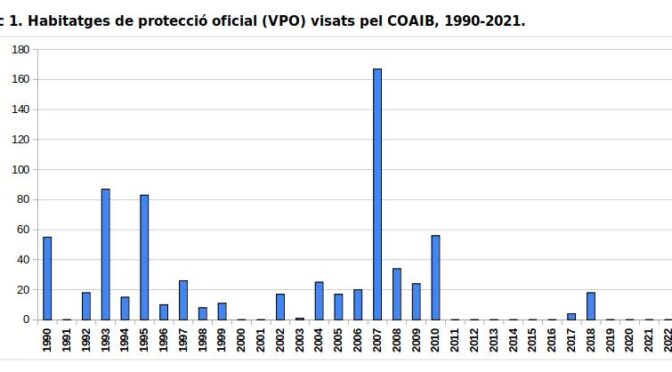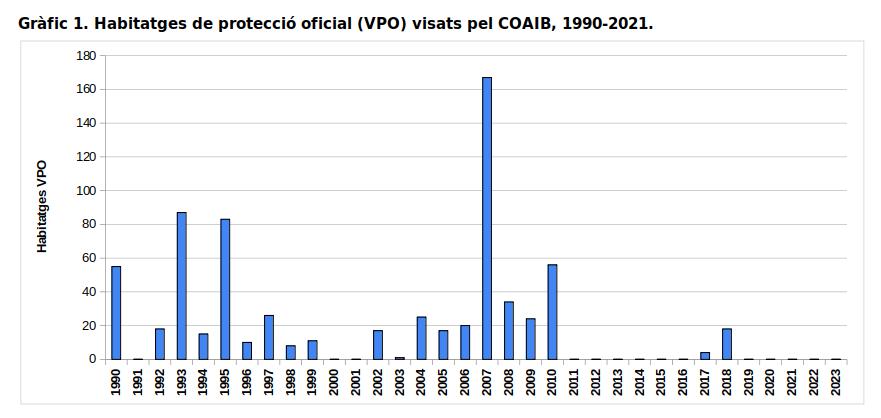Views: 224
Access to housing has become a problem in recent years in Menorca. Addressing this important social challenge is an increasingly urgent need, and data and reflection are required to take steps in the right direction.
In this note, based on official data, some of the variables most closely related to the situation are analyzed.
Social housing stopped in Menorca in 2011
Data from the System of Indicators of the Territorial Plan (PTI), prepared by OBSAM, show, in the latest report published in 2023, the evolution of social housing in Menorca.
In the 1990s, the building of subsidized housing was approved almost every year. In the attached chart, it can be seen that the most prolific year was 2007 (four years after the approval of the first PTI), when 167 buildings of affordable housing were approved. But the dynamic came to an abrupt halt in 2011.
The banking crisis of the previous years caused a stoppage of public funds. These were the well-known years of “austerity.” The halt in social housing remained at zero in the following years, with the timid exception of 2017 (with 4 affordable housing buildings) and 2018 (with 18). An evolution that can also be observed at the national level.
Therefore, Menorca was left practically orphaned of public housing policies from 2011 onwards.
The growing human pressure in summer also affects housing
This first factor is combined with another reality that aggravates it. According to data from the Balearic Institute of Statistics, dependent on the Balearic Government, in 2010 the peak of human pressure occurred on August 11, with 204,296 people on the island.
If we compare this data with that of 2024—the latest officially published—we see that the peak occurred on August 10, with 232,166 people. That is, 27,870 more people than 14 years earlier.
But even more serious is the accumulation of days with high human pressure. Let us look at it.
In 2010, there were 12 days that exceeded 200,000 people (from August 7 to 18, both included). In contrast, in 2024, there were 43 days that exceeded 200,000 people (from July 17 to August 28). In fact, there were more than 220,000 people for 20 consecutive days.
These data show the reality of the evolution of Menorca’s summer. There is always talk about deseasonalization, but the analysis shows how the overcrowding of summer has increased.
Tourist influx requires more external workers
This huge volume of people in July and August in Menorca is made up, for the most part, of tourists, who need accommodation. Secondly, such an enormous volume of tourists requires a great deal of labor, much of which also comes from outside and also needs accommodation.
This combined phenomenon is not usually mentioned when talking about the housing problem in Menorca. But it is a combination that drives demand to unprecedented levels on the island and that has a very significant impact on the speculative price bubble.
Lesson learned: building more free-market housing does not lower prices
In 1998, a Land Law (Ley del Suelo) was approved throughout Spain, which declared developable everything that was not strictly protected. Added to this was easy bank financing. Those were times of a lot of housing construction everywhere. But the price practically tripled in ten years. The greater supply continued to increase prices.
Real estate is a preferred destination for money seeking profitability and security. There is a lot of money looking for investments of this type, also on our island. For these reasons, building more housing or densifying areas through more intensive urban planning is not synonymous with lower prices. It only is when the administration intervenes effectively.
The serious problem of tourist rental
Menorca’s bet not to suffer tourist overcrowding was based on the containment of the growth of tourist accommodations set by the 2003 PTI, which even included maximum annual quotas.
But when this planning instrument was drafted, everyone understood that the key tool was to curb new accommodations. The new phenomenon of tourist rental had not yet arrived.
When digital platforms were launched that made it easier for anyone to directly rent already built houses as tourist accommodation, a new scenario quickly emerged where the containment of coastal urbanization construction was no longer enough to curb overcrowding.
By placing tourists in already built houses, there arises great competition in the use of these properties for residents. The prices that tourists are willing to pay are much higher than those of residents.
According to the Island Register of Companies, Activities, and Tourist Establishments of the Island Council, in 2022 (at the end of which the current tourist moratorium was enacted), Menorca already had more than 30,000 tourist rental places, almost equaling hotel places.
Lowering summer tourist pressure would ease the housing problem
As can be seen from the data provided, Menorca has suffered the combination of several factors that have negatively affected the availability of housing.
The halt in publicly initiated buildings coincided with the emergence of tourist rental and with a considerable increase in daily human pressure (the effect of the combination of more tourists and more tourist workers). Three elements that have added up to a highly problematic result.
To this reality, we must add a huge volume of undeclared but existing tourist rentals. Just look at the fact that Menorca has 100,000 registered residents and 84,000 tourist places, that is, space for about 184,000 people, while in practice we far exceed 220,000.
There are different indicators that show that we are exceeding the island’s carrying capacity in many respects: municipalities without enough water to supply residents, wastewater treatment plants that cannot properly complete the cycle due to excess volume, highly congested beaches, rapid filling of the solid waste landfill, the need to put obsolete engines of the thermal power plant into operation—despite the growth of solar parks–…
Avoiding excuses to build on rural land
It is very likely, as we are already seeing in some cases, that the difficulty of access to housing will be used as an excuse to be able to build where it is not foreseen, such as rural areas within transition areas—as promoted by the Balearic Government—or by converting farm buildings into housing—as proposed by the Island Council in the aborted attempt of rapid PTI modification.
The lack of available housing is a symptom of a model where short-term profit takes precedence over citizens’ rights, and a real and urgent problem for many people, especially for young people in Menorca who see their emancipation frustrated and their life projects stalled.
GOB believes that it is necessary to open the debate and apply effective measures to reduce the current human pressure of the summer, and seek to bring it to levels close to the month of June (around 180,000–190,000 people). This would ease many of the current tensions and contribute, much more effectively, to alleviating the availability of housing for residents.
Limiting tourist vehicles is a good tool to work towards such objectives.
Public opinion deserves a transparent and well-founded debate, and public institutions must be asked to rise to the challenge and act honestly.




